How to Qualify Leads: The Complete Guide to Sales Success
Here's everything you need to know, from creating an ICP to qualifying a lead.
— Propoze

Qualifying leads is all about saving time, maximizing your efforts, and building real, valuable connections.
Whether you’re new to sales or a seasoned pro, figuring out which leads are worth pursuing can feel like a guessing game.
But it doesn’t have to be!
In this guide, we’re breaking down everything you need to know about lead qualification, with practical steps and simple frameworks that work across industries.
We’ll cover common questions like, "How do you know if a lead is truly qualified?" and "What makes a lead worth your time?"—and we’ll show you how to automate parts of the process to make your life easier.
By the time we’re done, you’ll be ready to spot the perfect prospects, qualify them efficiently, and close deals faster than ever before. Ready? Let’s dive in!
What is lead qualification?
Lead qualification is the process of determining whether a potential customer (a lead) is worth pursuing by your sales team. In simple terms, it’s about identifying who’s serious about buying and who’s just browsing.
This step helps you save time, resources, and effort by focusing on leads that are more likely to convert into actual customers.
Imagine having a list of 100 leads.
Not all of them are ready to buy — some may not even need what you’re offering!
Lead qualification helps you narrow that list down to the people who not only fit your ideal customer profile but are also ready and willing to engage in a conversation.
Why is it important?
Because chasing every lead is a waste of time. Your team could be spending hours nurturing a lead that will never close.
Lead qualification allows you to focus on high-value prospects, improving conversion rates and closing deals faster.
When you figure out who has the interest, budget, and authority to make a purchasing decision, you’re not just increasing efficiency — you’re increasing your chances of success.
What qualifies a lead?
A lead is someone who has shown initial interest in your product or service, such as filling out a form, subscribing to a newsletter, or engaging with your website.
However, to move from being a lead to being a qualified lead, they need to meet certain criteria, like having the budget, need, and authority to purchase.
And not every lead is created equal.
Some people are ready to buy, while others are just window-shopping. To decide whether a lead is worth pursuing, there are a few key factors that help qualify them.
Now, which factors you’ll choose depends on which lead qualification framework you’re using. And we’ll get to that in a minute.
Different types of qualified leads: MQL vs SQL
When talking about lead qualification, two terms often come up — marketing qualified leads (MQLs) and sales qualified leads (SQLs).
Understanding the difference between the two is essential for aligning marketing and sales efforts and driving a more efficient sales funnel.

What is a marketing qualified lead (MQL)?
A marketing qualified lead (MQL) is someone who has shown interest in your product or service through marketing channels, but they aren’t quite ready to buy just yet. These are typically leads who have engaged with your content, downloaded an eBook, or signed up for a newsletter, but haven't had direct conversations with your sales team.
How do you identify an MQL?
Interactions like opening emails, visiting specific pages on your site (like pricing or product pages), or signing up for webinars.
- They fit your ideal customer profile but may not be ready to make a decision.
- Marketing teams generally use lead scoring systems to determine when an MQL is ready to be moved down the funnel.
What is a sales qualified lead (SQL)?
A sales qualified lead (SQL) is further down the funnel. SQLs have been vetted and are deemed ready to engage with the sales team. They’ve usually had direct interaction, such as responding positively to an outreach attempt, scheduling a call, or requesting a demo.
SQLs are more likely to be in the decision-making phase and are evaluating your product or service for purchase. The sales team steps in here to focus on closing the deal.
How do you identify an SQL?
- SQLs have shown clear buying intent through actions like booking a demo, requesting pricing details, or engaging in a discovery call.
- They’ve been qualified by marketing, and now it’s sales' job to determine if they’re ready to close.
How important is lead qualification in sales?
Let’s be real — trying to sell to everyone is a bit like throwing spaghetti at the wall and hoping something sticks. Not the most efficient approach, right?
That’s why lead qualification is inevitable in sales.
It’s all about zeroing in on the leads that are most likely to convert, so you can focus your time and energy where it really counts.
Why Is lead qualification crucial?
At its core, lead qualification helps businesses prioritize the right prospects. Not every lead is created equal, and chasing after unqualified leads can be a massive time sink.
Here’s why qualifying your leads is such a critical part of the sales process:
- Saves time and resources: Instead of wasting time on leads that are just browsing or don’t have the budget, lead qualification allows you to focus on the serious prospects — the ones who have the potential to become paying customers.
- Improves Conversion Rates: When you’re only working with leads that actually fit your target profile, your conversion rates naturally go up. You’re no longer casting a wide net and hoping for the best. Instead, you’re focusing on quality over quantity.
- Helps you work smarter, not harder: With a solid lead qualification process, your sales and marketing teams can work together more efficiently. Sales teams don’t have to chase down every lead, and marketing can focus on nurturing those who aren’t quite ready yet.
- Reduces friction in the sales process: Imagine a lead gets passed from marketing to sales, but the sales team quickly realizes the lead has no budget or authority to make a decision. Frustrating, right? Lead qualification reduces this friction by ensuring only the most promising leads get moved down the pipeline, smoothing out the entire process.
- Increases ROI on sales efforts: Time is money, especially in sales. By focusing your team on the right leads, you’ll see a better return on investment for your sales efforts. You’re putting your resources — both time and money — into the prospects that are most likely to convert, making each sales interaction more valuable.
In short, lead qualification is like having a cheat sheet for your sales process. It helps you identify the leads worth pursuing and saves you from wasting time on the ones who just aren’t a fit.
The result?
Higher conversions, better use of resources, and happier sales teams. Pretty cool, right?
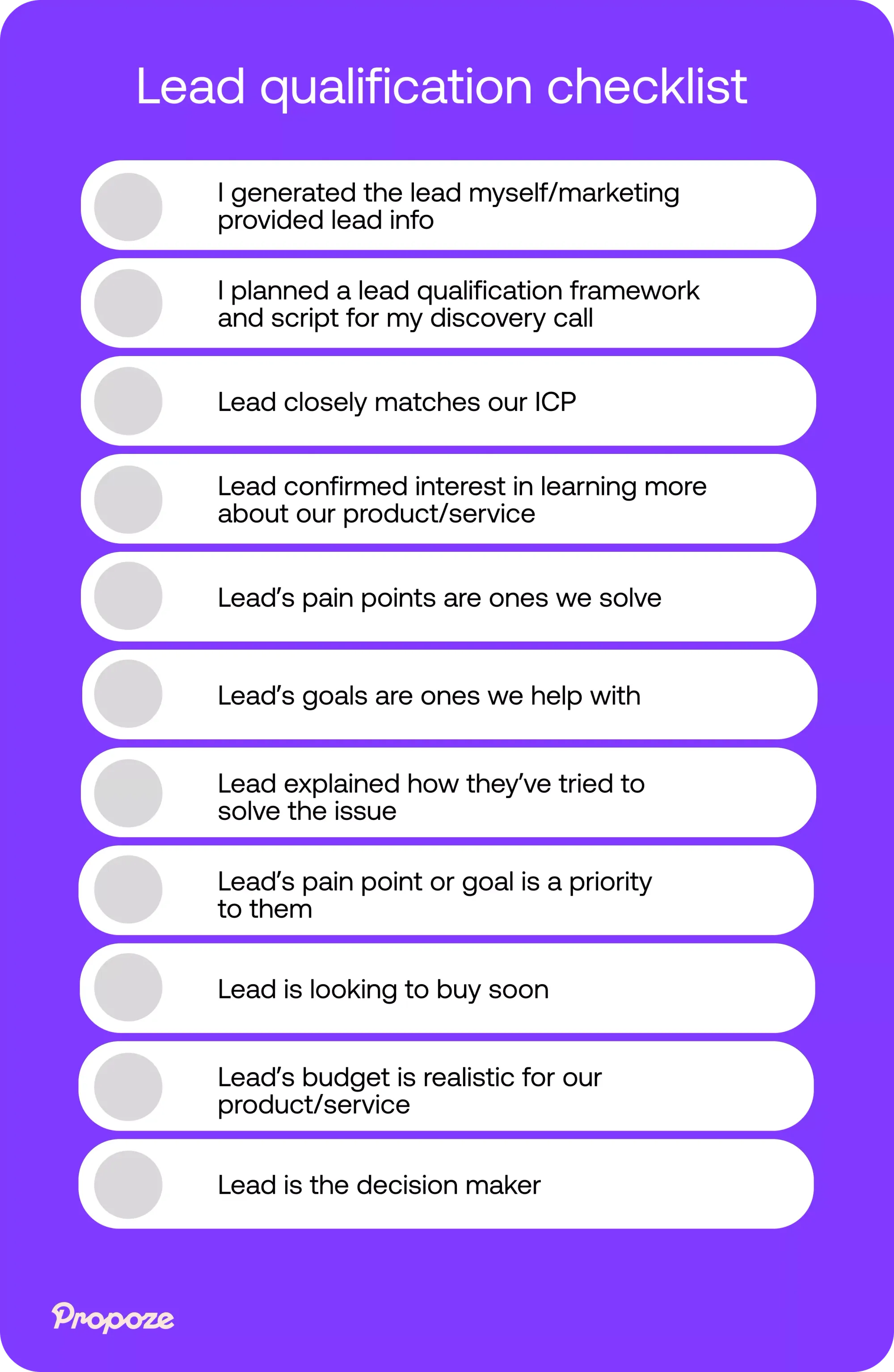
Lead qualification frameworks – which one should you use?
When it comes to figuring out if a lead is worth your time, having a clear framework can make all the difference. These frameworks provide a structure to help you ask the right questions and evaluate leads based on solid criteria. Here are a few of the most popular lead qualification frameworks:
BANT framework — Budget, Authority, Need, Timeline
BANT is a go-to for many sales teams, especially in the B2B space, because it’s straightforward and covers all the bases.
- Budget — Does the lead have the funds to afford what you're offering? It's best to figure this out early, so you're not chasing down leads that can’t pay. A simple way to ask is, "What's your budget for this project?"
- Authority — Are you talking to the person who can make decisions? If not, you’ll want to find out who has that final say. You might ask, "Who else will be involved in making the final decision?"
- Need — Does your product or service solve a real problem for the lead? You need to know their pain points and whether they need a solution sooner rather than later. A good opener could be, "What challenges are you currently facing that our solution can help with?"
- Timeline — How quickly does the lead need a solution? This helps you prioritize and figure out how fast you need to act. Try asking, "When are you looking to get this project started?"
BANT works because it quickly shows whether a lead is ready for the next steps or if it's better to move on to more qualified opportunities.
It’s simple, effective, and keeps your efforts focused where they matter most.
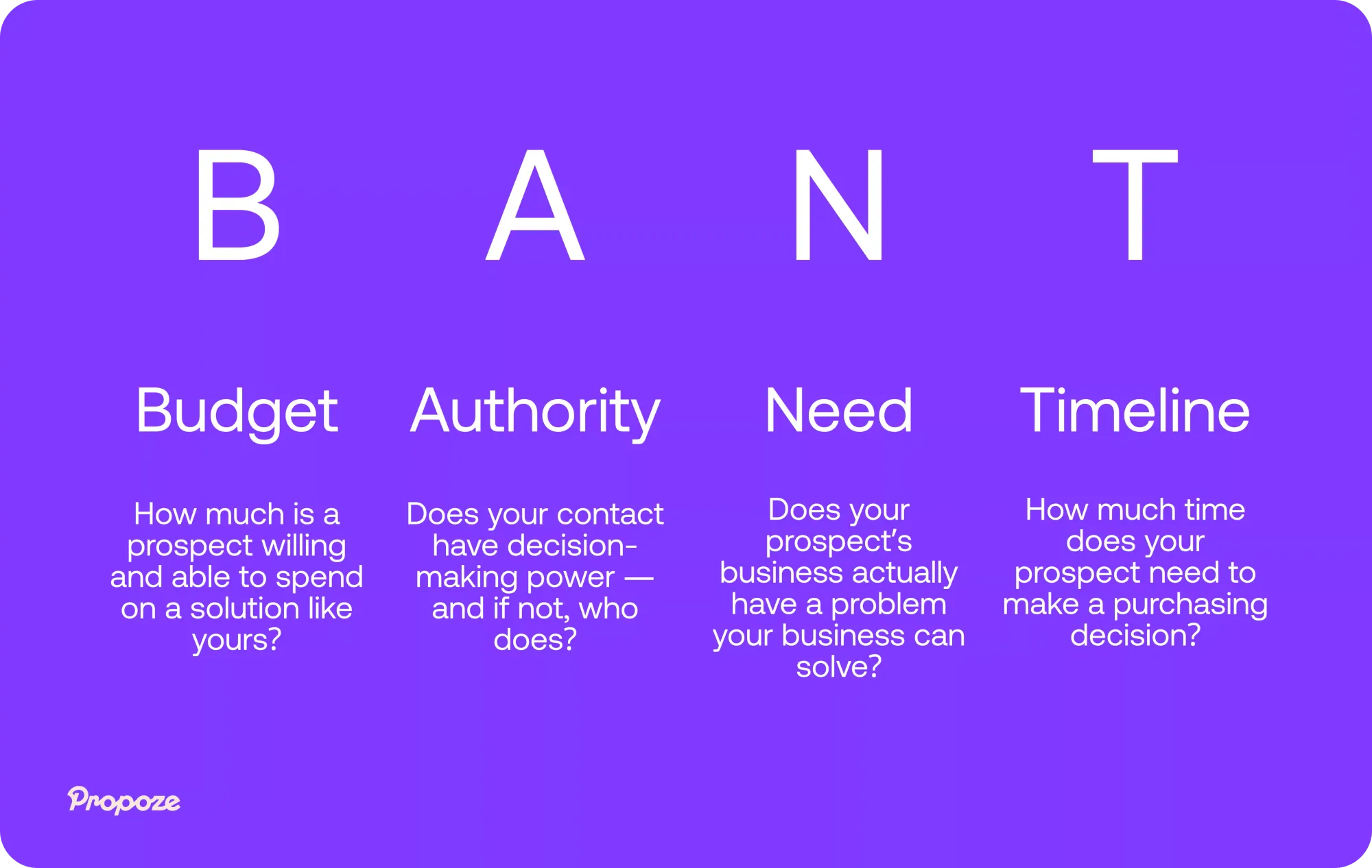
MEDDIC framework — Metrics, Economic Buyer, Decision Criteria
MEDDIC is perfect for sales where things get complicated — longer cycles, more people involved, and bigger decisions.
It really digs into the details to help you know if you’re talking to the right people and addressing the right needs.
Here’s how it works:
- Metrics — This part is all about numbers. What measurable outcomes is your lead looking for — whether it's boosting revenue, cutting costs, or improving efficiency? To get a feel for this, you could ask something like, “What specific results are you hoping to achieve with a solution like ours?”
- Economic buyer — Who’s in charge of making the final decision? The economic buyer is the person with the power to say yes or no, so you want to figure out who they are early on. You could ask, “Who will make the final decision on this purchase?”
- Decision criteria — What’s most important to the decision-makers? Whether it’s price, functionality, or ROI, knowing what factors influence their choice helps you tailor your approach. Try asking, “What factors are most important to you when choosing a solution?”
- Decision process — How does their company make decisions? Understanding their internal process — who’s involved and what steps are needed — helps you navigate the deal more smoothly. Ask, “Can you walk me through your decision-making process?”
- Identify Pain — What pain points are they trying to solve? The goal here is to uncover the biggest challenges the lead is facing, and show how your solution fixes them. You might ask, “What are the major challenges you're hoping to overcome?”
- Champion — A champion is someone within their organization who’s on your side — pushing to get your solution approved. You could ask, “Is there anyone on your team who’s really backing this project and can help move it forward?”
MEDDIC helps you focus on these six key areas, making it a great approach for complex sales with lots of decision-makers.
It helps you figure out which leads are worth your time and how to move them through the sales pipeline efficiently.
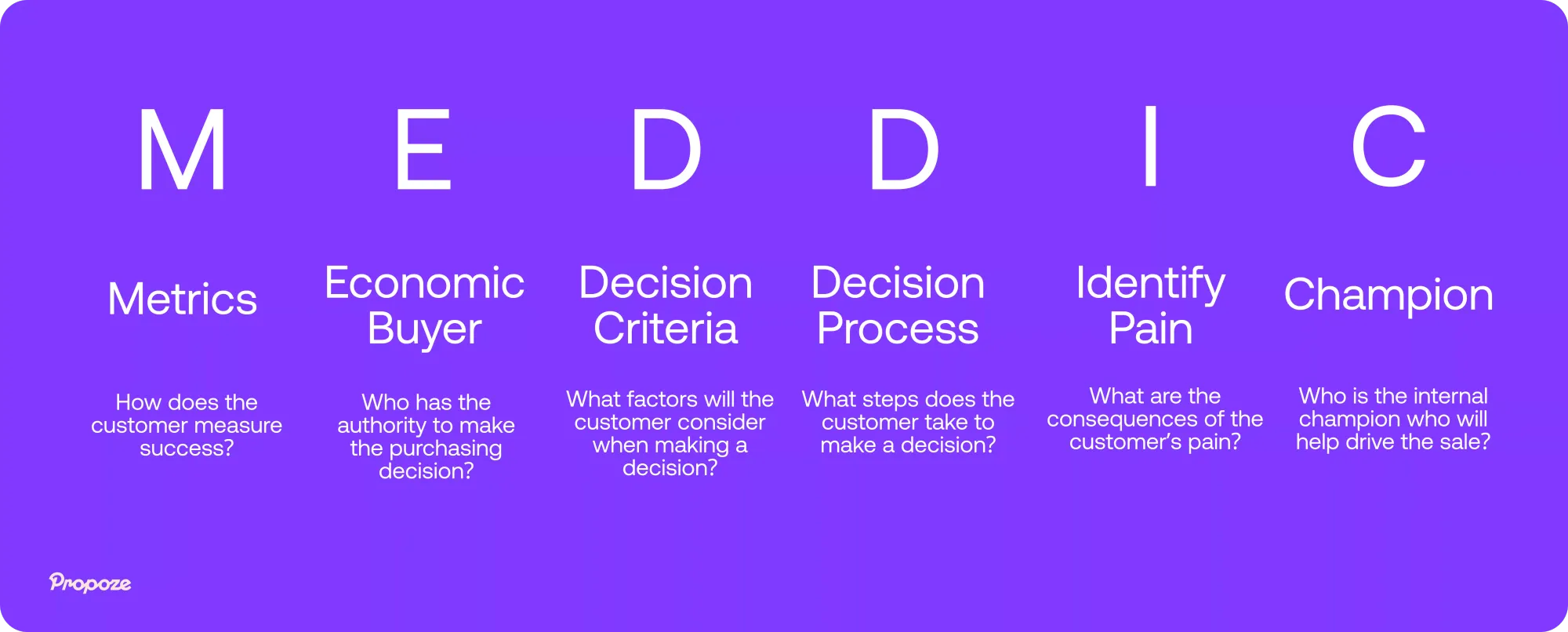
CHAMP framework — Challenges, Authority, Money, Prioritization
The CHAMP framework is all about digging into what really matters to your lead, and it takes a modern, more conversational approach to qualification.
It flips the script by focusing on understanding the lead’s challenges first, rather than jumping straight into budget or timelines.
Here’s how it breaks down:
- Challenges — The big idea here is to focus on the lead’s pain points right from the start. You’re not just selling a product — you’re offering a solution. Ask something like, “What challenges are you facing in (specific area)?” to get them talking about their needs. This not only helps you see if your solution is a good fit but also shows that you're genuinely interested in solving their problems, not just making a sale.
- Authority — Once you know their challenges, it’s time to figure out who’s calling the shots. You want to make sure you're dealing with the person who has the power to make a decision. A simple way to find out is to ask, “Who’s responsible for making the final call on this project?” That way, you know if you’re speaking with the right person or if you need to engage someone else.
- Money — Money talks, but with CHAMP, it doesn’t talk until after you’ve built a solid foundation. Once you’ve discussed challenges and authority, it’s easier to bring up the budget. You could say, “Do you have a budget allocated to tackle the challenges we’ve talked about?” By this point, they’ll already see the value in your solution, so the conversation about money feels more natural.
- Prioritization — Finally, it’s important to know how urgent solving these problems is for your lead. Even if they have the budget and authority, if your solution isn’t a top priority, they might not move forward. Ask, “How high of a priority is addressing these challenges?” or “Where does solving this issue rank among your other goals?”
The CHAMP framework works great for building trust and creating a strong connection with your prospects.
When you focus on their pain points first, you’re positioning yourself as a problem-solver, which makes them more likely to move forward with you.
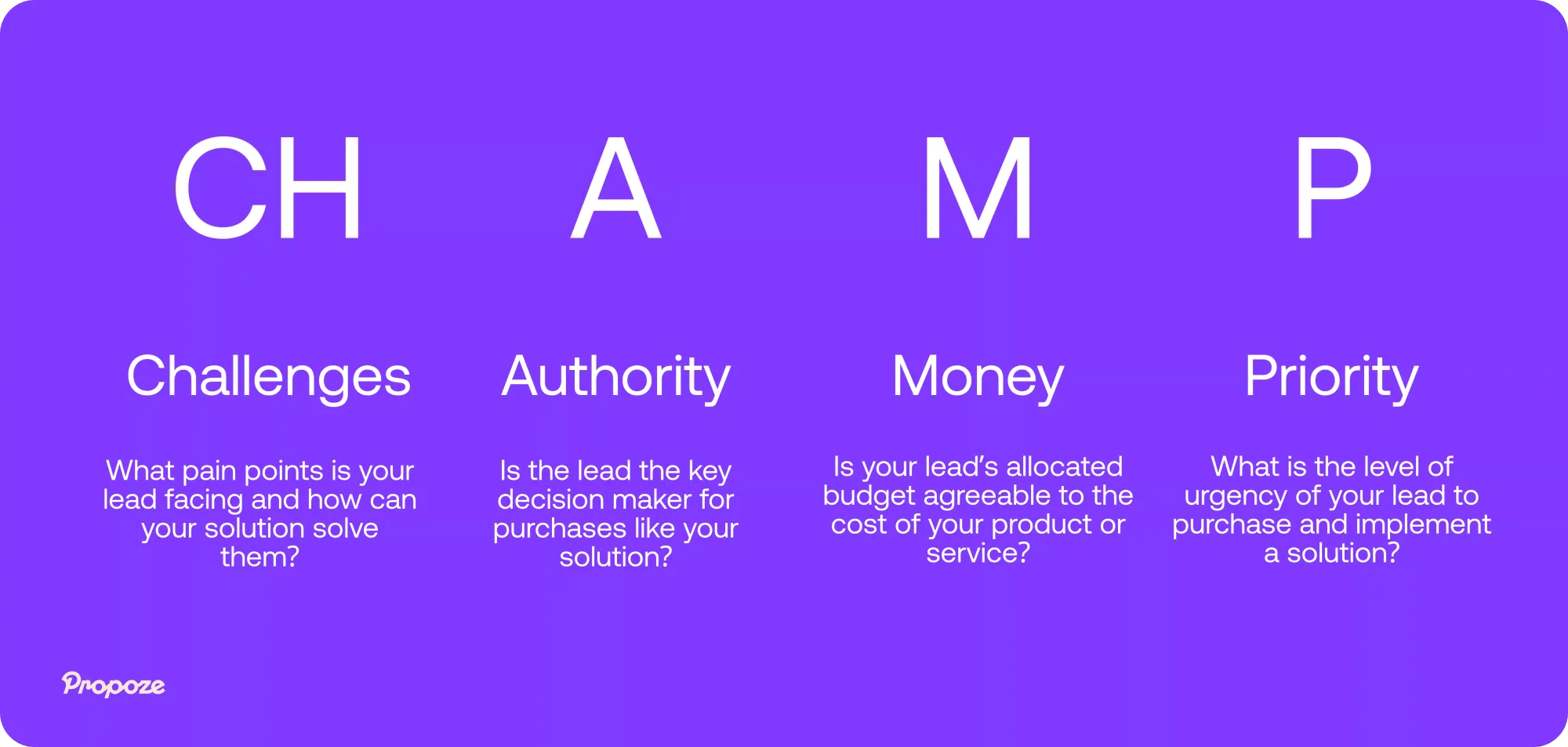
SPIN framework — Situation, Problem, Implication, Need-Payoff
The SPIN framework is a great way to lead more meaningful sales conversations by diving deep into your prospect’s needs before jumping into your solution. It’s like uncovering layers to really understand their challenges and showing how you can help.
Here’s how it plays out:
- Situation — First off, you want to get a feel for where the prospect is at right now. Ask questions that help you learn about their current setup or process, like, “How are you currently managing (specific task)?” or “What tools are you using for (area of business)?” This helps you understand what’s working for them and what’s not. It’s like setting the stage for everything that comes next.
- Problem — Now it’s time to dig into the pain points. What’s giving them trouble? Ask things like, “What challenges are you running into with (current process or tool)?” or “Where do you feel things aren’t going as smoothly as they should?” The goal is to uncover the real issues they’re dealing with, which positions you perfectly to offer your solution later.
- Implication — Here’s where you get them thinking about the cost of not solving those problems. You might ask, “What happens if this issue isn’t fixed?” or “How is this impacting your team’s efficiency?” This gets the prospect thinking about the ripple effect of their challenges, making the need for a solution feel more urgent.
- Need-payoff — Finally, you get to the fun part—showing how your solution can make a difference. Ask, “How would fixing this problem change things for you?” or “What improvements would you see if this issue were resolved?” This part is all about painting a picture of how much better things could be with your help. It gets the prospect excited about what you’re offering.
Using the SPIN framework keeps your conversation focused on the lead’s specific needs, making your pitch feel personalized and relevant.
Plus, by waiting to present your solution until after you’ve explored their problems, you make it much easier for them to see the value in what you’re offering.
It’s a win-win!
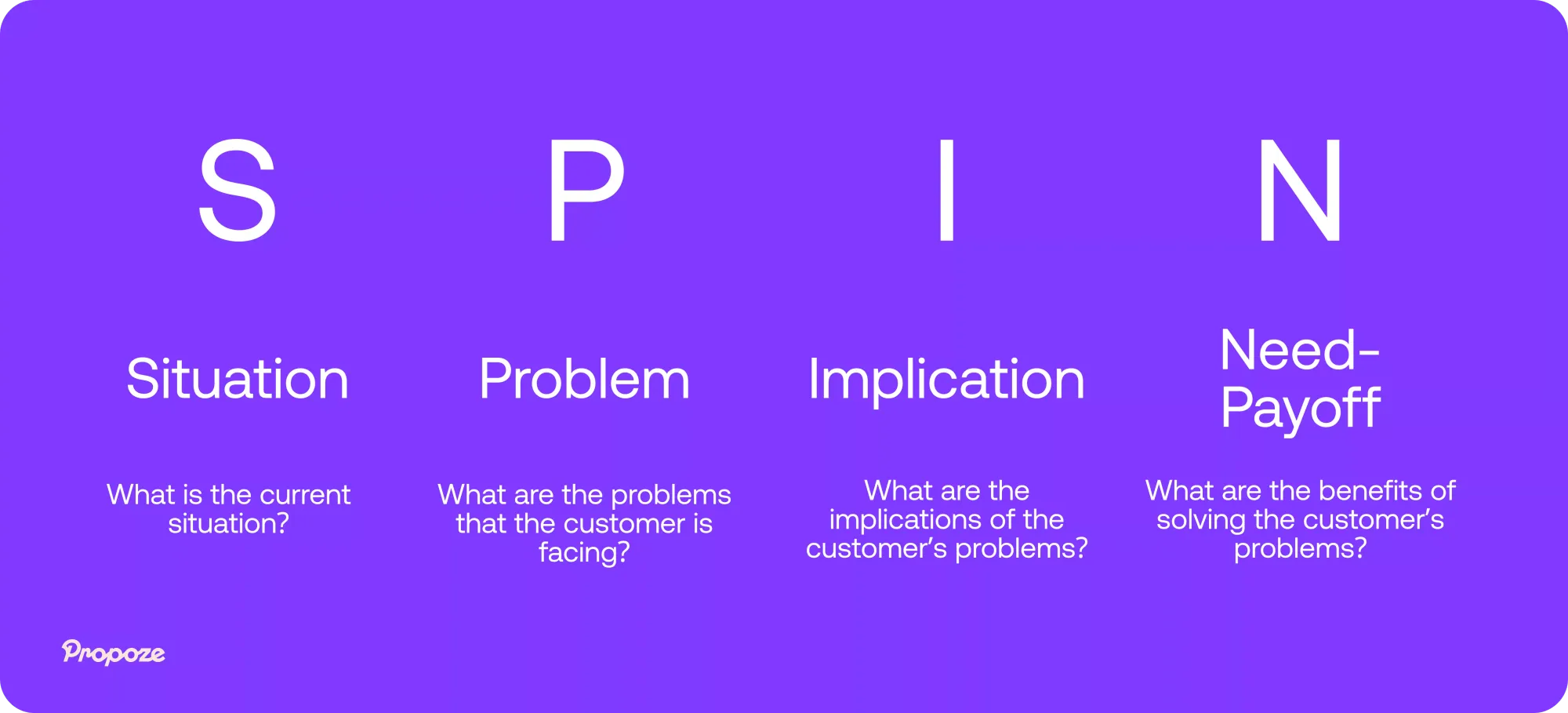
Step-by-step lead qualification process
Qualifying a lead is essential for maximizing sales efficiency and ensuring that your team is focusing on prospects who are most likely to convert.
Here's a step-by-step guide to help you understand how does a lead get qualified and how do you identify qualified leads.
Step 1: Define your ideal customer profile (ICP)
If you don’t know who your ideal customer is, you’re kind of just throwing darts in the dark.
That’s why defining your ICP is absolutely crucial — it’s the blueprint that tells you exactly who’s a perfect fit for your product or service.
What is an ICP?
An ICP is a detailed description of the type of customer that would be the best fit for your offering. It includes demographics, behavioral traits, and firmographic data.
It’s not just about which companies you’d like to work with — it’s about which companies are most likely to buy, benefit from, and stick with your product.
Why is this important?
Because without one, you’ll waste time chasing after leads who either aren’t ready or don’t need what you’re offering. By focusing on your ideal customer, you can:
- Target smarter — You’ll spend more time on the leads that are most likely to convert.
- Use your resources better — Marketing and sales efforts can zero in on the right people, saving time and effort.
- Cut the noise — Why chase leads that will never convert when you could be spending that energy on prospects who are the perfect fit?
How to create your ICP?
- Look at your best customers — Start with your current MVPs (most valuable players). What do they have in common? What industries are they in? What size are their companies? What kind of problems did they need help solving?
- Understand their pain points — Ask yourself, “What are the top problems my ideal customers are trying to solve?” The more clearly you understand their challenges, the better you can position your product as the solution.
- Firmographics and behavior — Consider details like industry, company size, and where they’re located. Also, think about their behavior—do they have a long buying cycle? Are they tech-savvy or need more hand-holding?
- Identify decision-makers — It’s not just about targeting companies—it’s about finding the right people within those companies. Who’s in charge of making the purchase decision? Aim your efforts at them.
Once you’ve nailed down your ICP, you’ll know exactly who to pursue, saving your team time and energy while boosting conversion rates.
The key takeaway? Not every lead is a good lead, and your ICP will help you narrow your focus to the ones that really matter.

Step 2: Lead scoring criteria
Now that you've nailed down your ideal customer profile, it’s time to kick it up a notch with lead scoring.
This is where things get exciting. Lead scoring helps you rank and prioritize your leads based on how likely they are to convert into paying customers.
Think of it as your go-to system for deciding which leads are worth your time and which ones need a bit more nurturing.
What is lead scoring?
Lead scoring is basically a system where you assign a point value to each lead based on specific criteria. Think of it as a way of gauging how "hot" a lead is by looking at how well they match your ICP and how engaged they are with your brand.
The higher the score, the better the fit — and the sooner your sales team should pounce!

What are key lead scoring criteria?
To make lead scoring super effective, you’ll want to break it down into a few categories.
Each category gets points, and those points help prioritize which leads to engage first.
- Fit (demographic and firmographic data) — Leads that match your ICP get a higher score. This could be based on their job role, industry, company size, or location.
- Example: If a lead is a decision-maker in a large company within your target industry, they could get 10 points, while a smaller business or non-decision-maker might get 5.
- Engagement (behavioral data) — Engagement measures how interested a lead is, based on their interactions with your brand. Have they been clicking on your emails? Visiting your site multiple times?
- Example: Leads who download a whitepaper or attend a webinar might get 5 points each. Requesting a demo? That’s a big deal—give them 20 points.
- Actions and behaviors (intent data) — Some actions show serious intent to buy, like visiting your pricing page or asking for more product details. These leads are closer to making a decision.
- Example: Someone who fills out a contact form or requests a demo could score 15-20 points, while browsing your blog might get them 5.
- Fit to buyer’s journey stage — Leads further along in the buyer’s journey — like those weighing their options or ready to purchase—should score higher than those just exploring.
- Example: If they’re in the decision phase, assign 30 points. Early-stage researchers? Give them 10.
- Negative scores (disqualification criteria) — Not all leads are worth chasing. If a lead doesn’t fit your ICP or hasn’t engaged in a long time, deduct points to avoid wasting time.
- Example: Leads from a non-target industry could get -10 points. If they haven’t opened any of your emails in months, maybe knock off 5 points.
And how does lead scoring help?
In short, lead scoring saves your team from wasting time on leads that are unlikely to convert. Instead of guessing, you're using real data to prioritize your outreach.
High-scoring leads get followed up on quickly, while the low-scorers might need a bit more nurturing before they’re ready to buy.
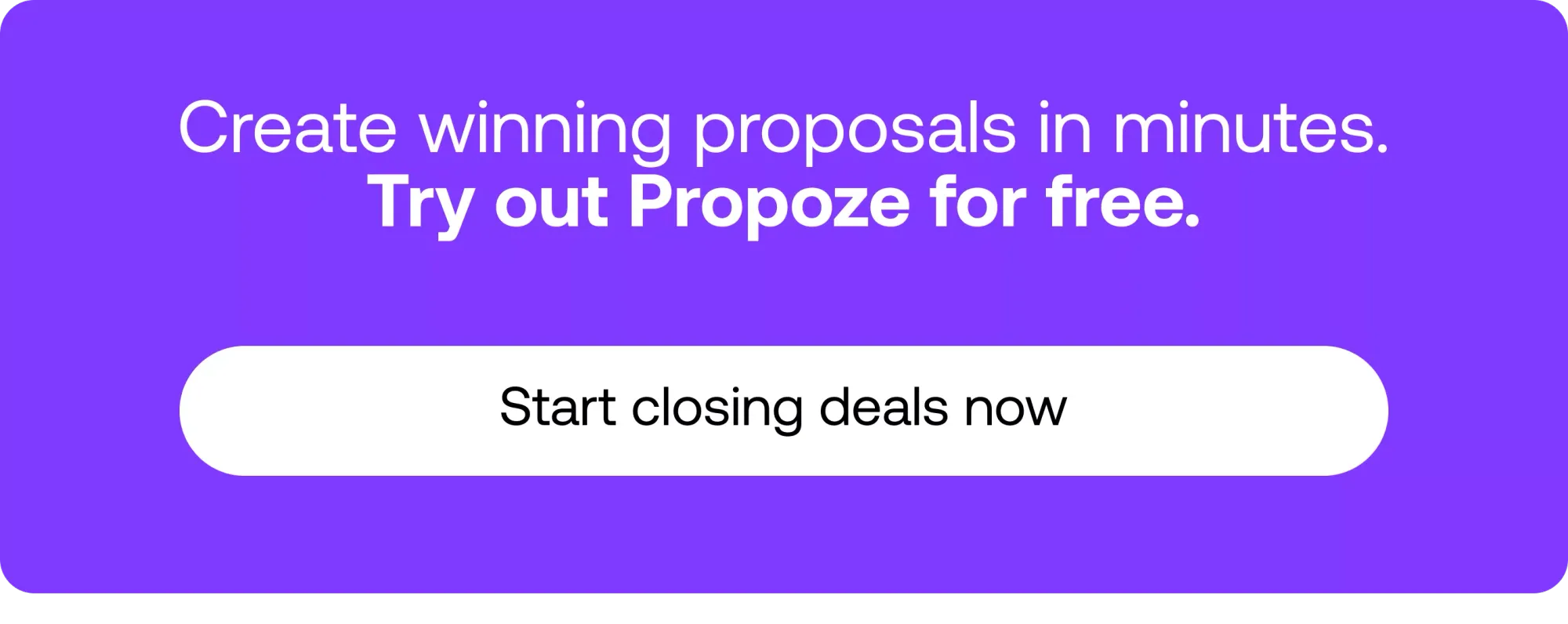
Step 3: Research and gather leads
Now that you know who you’re looking for (your ideal customer profile) and how to score them, it's time to gather and research leads.
Think of this as building your future customer base!
To make this process more effective, you can go about it two ways: inbound and outbound lead generation. Both have their strengths, and combining the two can give you a steady pipeline of potential clients.
Inbound lead generation
Inbound lead gen is all about drawing leads to you. By offering value upfront, you attract people who are already interested and more likely to convert.
Let’s break it down:
- Website forms — Ever filled out a form for a free ebook or newsletter? That’s inbound lead generation. Offering valuable resources in exchange for contact details is a great way to build a lead list.
- Content marketing — Regular blog posts, case studies, or helpful guides do wonders for attracting leads who are researching solutions. By addressing their pain points and offering advice, you position yourself as an authority in your field.
- Social media engagement — Get social! Platforms like LinkedIn, Twitter, and Facebook aren’t just for sharing memes. Engaging with prospects, sharing your content, and participating in discussions are ways to draw inbound leads.
- Webinars & events — Hosting webinars or online events is an excellent way to showcase your expertise while gathering lead info. Plus, you get the bonus of live engagement from attendees who are genuinely interested.
Outbound lead generation
Outbound methods involve reaching out to potential leads directly, even if they’ve never heard of you before.
These leads might be "cold," but with the right approach, you can warm them up.
- Cold email outreach — Sending targeted emails to prospects can introduce your business and solution to people who haven’t come across it before. Make each email personal and focused on solving their specific challenges.
- Social selling — Platforms like LinkedIn allow you to connect directly with prospects. By engaging with their posts and sending personalized messages, you can nurture relationships that might lead to a sale.
- Sales outreach — Good ol' fashioned cold calls still work. Pick up the phone and have your sales team reach out to potential leads, learn about their challenges, and introduce your solution.
- Trade shows & networking events — Trade shows and industry events are fantastic for collecting leads. These face-to-face interactions can build strong relationships that may lead to business opportunities down the line.
The magic happens when you combine these strategies!
Inbound brings leads who are already interested, while outbound helps you proactively target your ideal customers. By balancing both, you'll build a steady stream of qualified leads who are ready to convert.
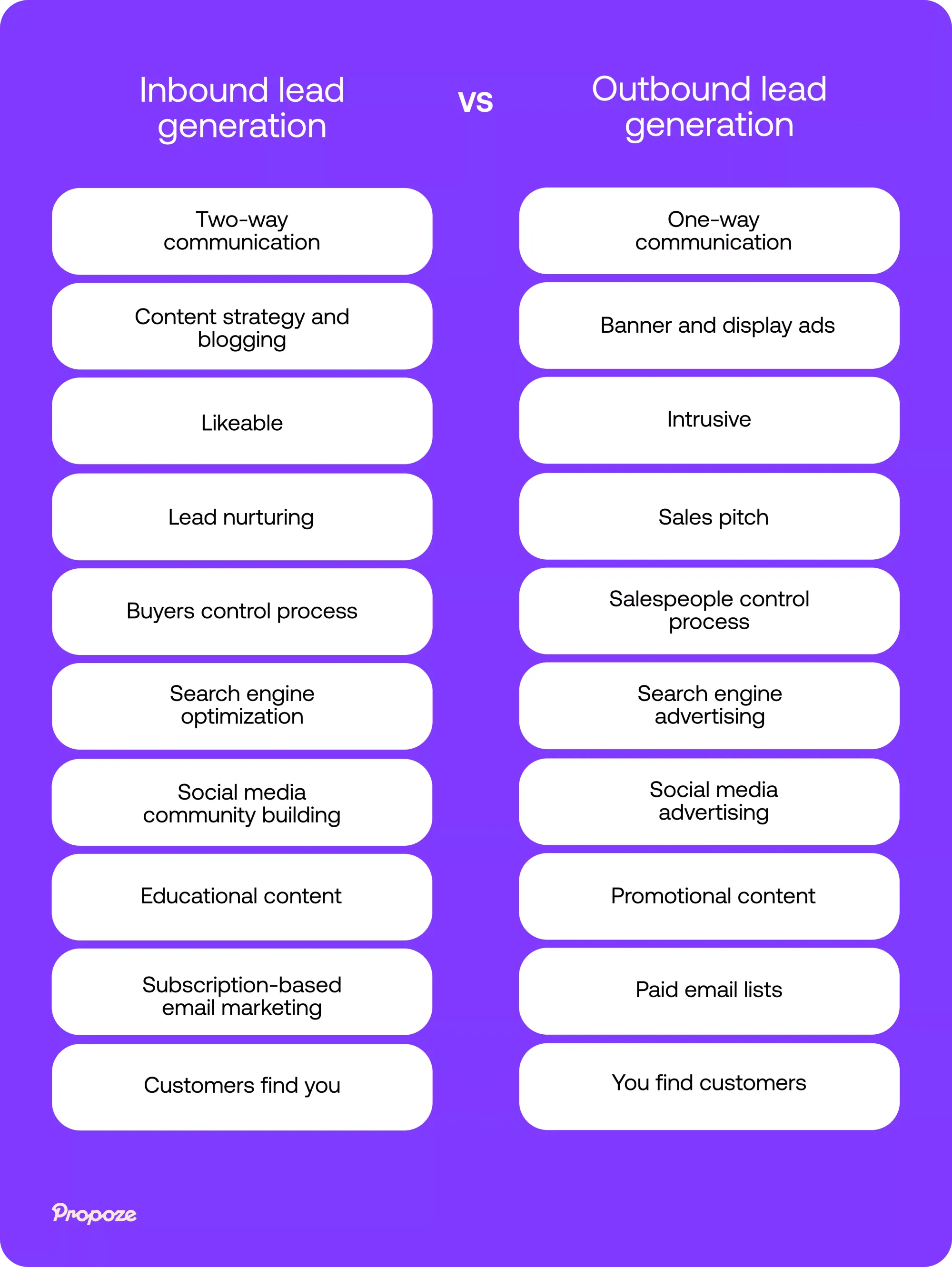
Step 4: Ask the right qualification questions with context
Instead of firing off a list of questions like a robot, think of lead qualification as a conversation. Your goal isn’t just to tick boxes, but to really understand the lead’s needs and challenges.
Asking questions with context will get you better insights while keeping the discussion natural and comfortable for your prospect.
1. Start with open-ended questions
Don’t dive right into technical questions like budgets or timelines. Open up the conversation by asking broad, open-ended questions that get them talking about their pain points and goals. It’s less intimidating for them and helps you build rapport.
For example, instead of jumping to “What’s your budget?”, try something like, “What’s your biggest hurdle right now when it comes to [insert problem]?” This sets a conversational tone, allowing the lead to share more about their situation.
2. Tailor your questions based on their responses
As the conversation unfolds, listen closely and ask follow-up questions based on what they’ve said. If a lead mentions they’re struggling with budget constraints, you can naturally steer the conversation toward budget without it feeling forced. The goal is to respond in the moment rather than sticking to a strict script.
For example, if they say they’re worried about costs, you can ask, “How are you currently managing your budget for this?” It feels more like a dialogue than an interrogation.
3. Use frameworks as guidelines, not a script
Lead qualification frameworks like BANT (Budget, Authority, Need, Timeline) or CHAMP (Challenges, Authority, Money, Prioritization) are useful, but they’re not meant to be recited like a script.
Let the conversation flow naturally, and don’t feel like you have to check off each box if the information comes up organically. If the lead has already hinted at who makes decisions, no need to ask directly — you’re still getting the same insight.
4. Think of it as discovery, not just qualification
You’re not just qualifying leads — you’re helping them think through their own challenges and needs. Insightful questions can lead your prospect to realize how much they need your solution.
For instance, asking something like, “What’s holding you back from solving [X problem] right now?” can prompt the lead to consider their urgency and gaps, making your product or service even more appealing.
5. Use the "Three Yeses" rule
A great way to keep the conversation positive is the “three yeses” technique. Start by asking easy, agreeable questions that the lead is likely to respond to with a “yes.”
For example, “Would a faster turnaround time help you meet your goals?” This helps build trust and comfort before you transition to more challenging questions like budgets and decision-makers.

Step 5: Score and review leads
Now that you’ve gathered some solid info from your leads, it’s time to give them a score and keep tweaking that score as you learn more.
This is where you really start to see which leads are worth your time and which ones might not be a great fit.
1. Build a scoring system
First things first — set up a scoring system that works for your business. What should you consider?
- Demographics: Is this lead the type of company you usually work with?
- Behavior: Are they opening your emails or checking out your pricing page?
- Intent: Have they requested a demo or showed interest in making a purchase soon?
Each of these factors gets a point value, depending on how important it is to you.
For instance, visiting your pricing page could be a big deal, so you might give that a higher score.
2. Keep adjusting the scores
Scoring isn’t a one-time thing. As you get more interactions, you’ll want to update the lead’s score.
Did they sign up for a webinar or read your latest email? Bump that score up! Haven’t heard from them in a while? Maybe knock it down a bit.
It’s about staying on top of the relationship and adjusting based on what they’re doing (or not doing).
3. Review and refine your criteria
Every now and then, take a step back and ask yourself: Are the leads with high scores actually converting into customers? Are there certain behaviors or traits that you should be scoring higher or lower?
By looking at the data from deals that went well, you can keep improving your system and make sure you’re focusing on the leads that are most likely to turn into business.
4. Get feedback from the sales team
Talk to your sales team! They’re the ones working with the leads day-to-day, so their input is gold.
Are they happy with the leads they’re getting, or are they spending too much time on leads that go nowhere?
Use their feedback to tweak your scoring system and make sure everyone’s on the same page.
When to disqualify a lead?
Not every lead is going to be worth your time. Sometimes, no matter how much effort you put in, the stars just aren’t aligned, and it’s better to know when to move on.
So, how do you know when a lead isn’t worth the chase?
Here are a few key signs that tell you it’s time to cut ties and focus your energy elsewhere.
Reason 1: No budget, no deal
If your prospect doesn’t have the budget — or if they’re not willing to discuss it — that’s a big red flag. Sure, you can offer some flexibility, but if a lead straight-up can’t afford your services, it’s likely not worth your time. Instead of pushing, save that energy for someone who’s got the resources to make things happen.
Reason 2: No decision-making power
You might find yourself talking to someone super enthusiastic about your product, but here’s the kicker: they don’t have the authority to actually greenlight the deal. If they don’t have the power to make decisions (or can’t influence the ones who do), it’s best to shift focus. Politely ask to connect with a decision-maker, or move on.
Reason 3: Needs don’t match your offering
Sometimes, even though a lead might seem perfect on paper, their needs just don’t align with what you offer. It happens. Maybe their challenges are outside of your wheelhouse, or they’re looking for something super specific that you can’t provide. In these cases, being honest with yourself (and them) is the best move. There's no point wasting time trying to fit a square peg in a round hole.
Reason 4: No urgency to act
Ever had a lead that loves what you’re offering but just keeps saying, “Maybe later”? That lack of urgency can really drag out your sales cycle. If they don’t feel the pain or need to solve their problem soon, you’re better off focusing on leads that are ready to act now.
Reason 5: No engagement
You’ve sent emails, left voicemails, and followed up repeatedly. Crickets. When a lead goes silent, that’s usually a good sign they’re not interested — or that they’ve found another solution. Either way, it’s time to stop chasing.
Reason 6: Overly high demands
If a lead is constantly asking for customizations, discounts, or extras that push your boundaries, it might be more trouble than it’s worth. Sure, negotiations are normal, but if a lead’s demands start to outweigh the value they bring, it’s okay to say, “Thanks, but no thanks.”
Reason 7: The timing’s off
If a prospect tells you now’s just not the right time, don’t force it. Sometimes the timing isn’t right, and pushing too hard might backfire. Politely follow up down the road, but in the meantime, focus on other, more ready-to-buy leads.

Start qualifying your leads today
At the end of the day, effective lead qualification is all about continuous improvement.
By refining your process, automating where it makes sense, and ensuring alignment between marketing and sales, you’ll be able to focus on the leads that actually matter — boosting conversions and driving growth.
Here’s how to make it happen:
- Refine your criteria: Stay flexible. Your lead qualification process should evolve as your business and customers do. Keep tweaking and adjusting based on what’s working.
- Automate where you can: Use CRMs and automation tools to handle repetitive tasks, like lead scoring and follow-ups, so you can focus on the high-value conversations.
- Align marketing and sales: Make sure both teams are on the same page about what a qualified lead looks like. This alignment ensures smoother transitions and faster conversions.
The time to refine and automate is now! Implement these strategies, and watch your sales pipeline get more efficient and your success rates soar.
And if you're looking for help on improving your sales process altogether, give Propoze a try and optimize your proposals for maximum sales results!